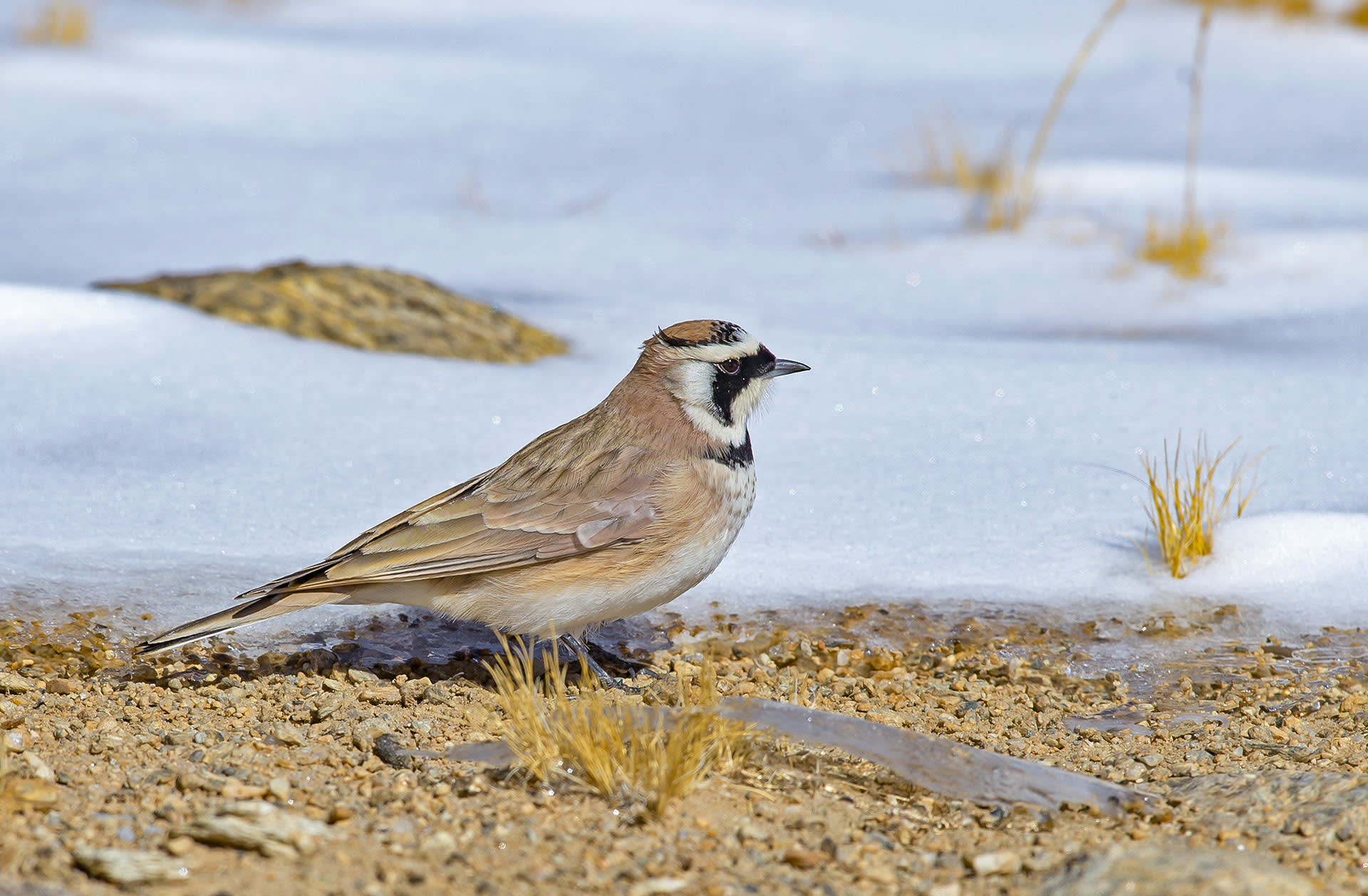It was August and I was in Ladakh. Being an enthusiastic birder, I was quite excited. Situated in the trans-Himalaya, a rare mix of high altitude and a cold desert, Ladakh is very special. Some of the birds seen in Ladakh are very similar to the ones seen in Rajasthan’s Thar desert except that Ladakh is a good 3,000 – 5000 m higher! Also, a number of migratory birds that we see in the plains every winter either pass through Ladakh on their way south or actually breed in Ladakh in summers and come down as the winters set in.
There was one bird that I was besotted by and specifically wanted to see — the horned lark. I had seen a picture of the bird, it looked like an annoyed royal, standing upright on its long straight legs, with sharp horns made of fine feathers jutting out on either side of its head like twirled ends of the moustache.
On my third day in Ladakh, the gentle and full-of-laughter Karma Le of the Nature Conservation Foundation took me to his home village of Rumtse on the Leh-Manali highway. His daughter ran a small roadside food store where travellers and truckers stopped to eat. While hanging out there, I noticed a little bird on the roadside looking for something in the sand. “Is it a horned lark?” I asked, excitement surging inside me. Here was the bird I was dreaming about spotting — right in front of me. I quickly jumped up, pulled out my camera and walked briskly towards the bird, hoping to take some shots without disturbing it. But disturb I did! And in one swift move, the object of my fascination flew over the roadside edge to the other side. Seeing disappointment written all over my face, Karma le reassured me, “It is very common Peeyush Le – it will come back, I suspect it feeds on the grains that fall off the trucks that park here.”
But, of course I was disappointed! I hadn’t even managed to get a decent look at the bird and its glorious horns, leave alone get a picture — and it was gone.

When the horned lark forages for food, it doesn’t fly. Instead, it walks or runs on the ground looking for insects, seeds, berries and fruits. Photo: Dhritiman Mukherjee
Cover: A black mask and tiny hornlike feathers on its head give the horned lark a perpetually angry look. The female does not have the ‘horns’ and is of a duller colour.
Cover photo: Dhritiman Mukherjee
But Karma Le was right. Over the next few days, we saw quite a few of them — at the roadside or as we took walks in the wilderness around the village. It was a rather funny sort of bird, a bit of a busybody running around, standing erect on rocks, its horns catching the breeze, not too bothered about human presence and scooting off when it felt like. I even managed to get decent shots. We got back to Leh after a few days. Abhijit and Deepshika of the Nature Conservation Foundation (NCF) had joined the team from Spiti, another high-altitude cold desert area in the trans-Himalaya in Himachal Pradesh — very similar to Ladakh but at some distance. I was telling them about my joyous sightings of the horned lark and Abhijit interjected saying that this bird is called “ribcha kolt” translated to “crazy bird” in Spitian! Why was my dear regal-looking horned lark called crazy I asked Abhijit, a little hurt. That’s when he told me something very interesting. This bird showed a capacity to build its nests absolutely anywhere — on compound walls, next to pathways, even on the open ground. It almost seems as if it doesn’t have a bother in the world and chooses its nest in such a location that everybody could enjoy seeing its young ones growing up. Unfortunately, this plan doesn’t always work out well as it loses its young ones to a long list of predators quite often. No wonder the people of Spiti call it the crazy one. This left me thinking. Humans have inhabited this land for a few thousand years and so maybe the bird has become habituated to coexist with humans. Without the fear of humans, this bird is common at this altitude and is clearly doing well. So even though it loses its young ones to predators there seem to be a large number that survive.
“I want to see a nest, a crazy nest,” I told Abhijit. “This is not the breeding season and I don’t even know whether the bird displays similar behavior in Ladakh,” Abhijit laughed. Karma Le and Deepshikha too joined in and had a good laugh.
(Left) A juvenile horned lark seen near Tsokar Lake in Ladakh. The bird is called chipa-gut or up-tshakir in Ladakhi. (Right) Though well-camouflaged, these ground nesting birds are at risk to rising dog populations and other disturbances such as increased movement of sheep in the landscape. Photos: Amitrane/Shutterstock (left), Peeyush Sekhsaria (right)
I was in the last leg of my trip. With Dorje Le, an old friend of Karma Le, we headed to the high-altitude lake of Tsokar. Quite a beautiful landscape, it was cold and windy and there seemed to be chances of rain. Tsokar is rich in birdlife and wildlife. As we walked, I chanced upon a perfect circular depression in the earth, lined with dry grass. It seemed very unusual, a perfect circular depression as if made with a machine. “Could it be the nest of the crazy one?” I asked Dorje Le. “Yes! It is an abandoned nest of the horned lark,” Dorje Le confirmed. Thrilled, I took a few pictures for record-keeping, so that I could confirm with Abhijit and others.
What a perfect circular depression of a nest, neat and small. Seeing this perfect piece of architecture, my respect and fascination for the horned lark only increased.
